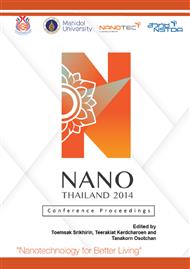p.110
p.117
p.123
p.131
p.135
p.139
p.146
p.153
p.157
Electrophoretic Deposition of Nanostructured Zinc Oxide Film Sensitized with Palladium Chloride for Butane/Propane Gas Sensing
Abstract:
Zinc oxide (ZnO) films on graphite substrate were fabricated using electrophoretic deposition (EPD) method. The effect of concentration and applied voltage in EPD were determined in which the mass of deposited ZnO depends on the applied voltage and not on the concentration. Sensitization of film with palladium chloride (PdCl2) was done through dipping method. The optimum number of dipping is 20. The sensitized samples were subjected to annealing at 100 °C for 30 minutes. The morphology of the films was analyzed through scanning electron microscopy (SEM) which showed the porosity and thickness of the samples. The IV characterization of the samples was done via four-point probe method and the resistivity and resistance were calculated. The resistivity and resistance were found to be lowest in graphite substrate while the films with palladium (Pd) showed lower values of resistivity and resistance than the films without palladium. . A three trial gas sensing experiment at room temperature was performed in which the response of the film to butane/propane gas (LPG) was tested and showed that it successfully sensed the gas. The sample with Pd deposited at the highest applied voltage showed the best gas response and response time among the other samples.Zinc Oxide (ZnO) films on graphite substrate were fabricated using Electrophoretic Deposition (EPD) method. The effect of concentration and applied voltage in EPD were determined in which the mass of deposited ZnO depends on the applied voltage and not on the concentration. Sensitization of film with Palladium Chloride (PdCl2) was done through dipping method. The optimum number of dipping is 20. The sensitized samples were subjected to annealing at 100 °C for 30 minutes. The morphology of the films was analyzed through Scanning Electron Microscopy (SEM) which showed the porosity and thickness of the samples. The IV characterization of the samples was done via four-point probe method and the resistivity and resistance were calculated. The resistivity and resistance was found to be lowest in graphite substrate while the films with palladium (Pd) showed lower values of resistivity and resistance than the films without palladium. . A three trial gas sensing experiment at room temperature was performed in which the sensitivity of the film to butane/propane gas (LPG) was tested and showed that it successfully sensed the gas. The sample with Pd deposited at the highest applied voltage showed the best sensitivity and response time among the other samples.
Info:
Periodical:
Pages:
135-138
Citation:
Online since:
December 2015
Authors:
Keywords:
Price:
Сopyright:
© 2016 Trans Tech Publications Ltd. All Rights Reserved
Share:
Citation:


